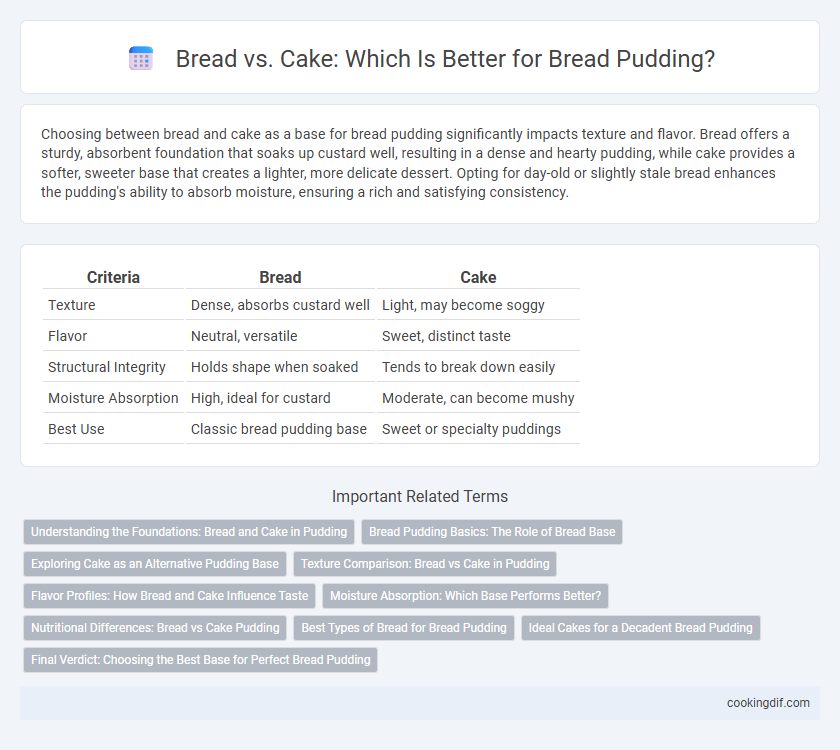Choosing between bread and cake as a base for bread pudding significantly impacts texture and flavor. Bread offers a sturdy, absorbent foundation that soaks up custard well, resulting in a dense and hearty pudding, while cake provides a softer, sweeter base that creates a lighter, more delicate dessert. Opting for day-old or slightly stale bread enhances the pudding's ability to absorb moisture, ensuring a rich and satisfying consistency.
Table of Comparison
| Criteria | Bread | Cake |
|---|---|---|
| Texture | Dense, absorbs custard well | Light, may become soggy |
| Flavor | Neutral, versatile | Sweet, distinct taste |
| Structural Integrity | Holds shape when soaked | Tends to break down easily |
| Moisture Absorption | High, ideal for custard | Moderate, can become mushy |
| Best Use | Classic bread pudding base | Sweet or specialty puddings |
Understanding the Foundations: Bread and Cake in Pudding
Bread pudding thrives on the sturdy texture and mild flavor of day-old bread, which soaks up custard without becoming overly dense or soggy, making it ideal for a balanced pudding base. Cake, with its lighter crumb and higher sugar content, absorbs liquids quickly, resulting in a sweeter but less structured pudding that can easily become mushy. Choosing between bread and cake as a foundation impacts the final pudding's texture, sweetness, and resilience, with bread offering robustness and cake providing softness and flavor intensity.
Bread Pudding Basics: The Role of Bread Base
Bread pudding's texture and flavor largely depend on the type of bread used as the base, with stale bread preferred for its ability to absorb custard without becoming soggy. Dense breads like brioche or challah enrich the pudding with a buttery taste and tender crumb, while lighter breads such as white or French bread offer a more neutral canvas for spices and additions. Choosing the right bread ensures optimal custard absorption, achieving the perfect balance between moistness and structure in classic bread pudding recipes.
Exploring Cake as an Alternative Pudding Base
Using cake as an alternative base for bread pudding enhances texture by introducing a lighter, more tender crumb compared to traditional bread, which often provides a denser foundation. Cake absorbs custard differently, creating a creamier consistency and allowing for unique flavor infusions such as vanilla or chocolate that are typically less pronounced in bread-based puddings. This substitution expands creative possibilities in pudding recipes, catering to various taste preferences and dietary considerations.
Texture Comparison: Bread vs Cake in Pudding
Bread provides a denser, chewier texture that absorbs custard well, creating a firm yet moist bread pudding base. Cake contributes a lighter, airier consistency that results in a softer, more delicate pudding with a melt-in-the-mouth feel. Choosing bread intensifies the pudding's heartiness, while cake offers a tender, subtle crumb that enhances sweetness.
Flavor Profiles: How Bread and Cake Influence Taste
Bread provides a denser texture and a more neutral flavor that absorbs custard deeply, enhancing the rich, creamy notes of bread pudding. Cake contributes a lighter, sweeter base with subtle buttery and vanilla undertones, creating a more delicate and dessert-like flavor profile. Choosing between bread and cake as the base significantly impacts the pudding's overall taste and mouthfeel, tailoring it toward either rustic comfort or upscale sweetness.
Moisture Absorption: Which Base Performs Better?
Bread absorbs custard more effectively than cake due to its porous texture, allowing for better moisture retention in bread pudding. Cake, being denser and often containing added fats and sugars, tends to absorb less liquid, resulting in a less moist final dish. Consequently, bread is the preferred base for a classic, moist bread pudding that balances texture and flavor.
Nutritional Differences: Bread vs Cake Pudding
Bread pudding made with traditional bread tends to have fewer calories and less sugar compared to cake-based pudding, offering a more balanced nutritional profile. Bread contains complex carbohydrates and dietary fiber, contributing to slower digestion and more stable blood sugar levels. In contrast, cake used in pudding often contains higher amounts of saturated fats and added sugars, increasing the overall caloric density and glycemic index of the dish.
Best Types of Bread for Bread Pudding
Dense, slightly stale bread varieties such as brioche, challah, and French baguette create the best base for bread pudding due to their ability to absorb custard without becoming mushy. Whole wheat and sourdough add depth of flavor and texture, enhancing the pudding's richness and complexity. Avoid soft sandwich breads that tend to disintegrate and result in a soggy, less structured dessert.
Ideal Cakes for a Decadent Bread Pudding
Choosing the ideal cake for a decadent bread pudding base enhances texture and flavor, with brioche and challah standing out for their rich, buttery crumb that soaks up custard perfectly. Pound cake offers a dense, moist foundation that provides structure while absorbing vanilla or cinnamon-infused custard efficiently. Angel food cake, though lighter, adds a delicate sweetness that balances creamy custard, resulting in a sophisticated bread pudding experience.
Final Verdict: Choosing the Best Base for Perfect Bread Pudding
Choosing the best base for perfect bread pudding depends on texture and flavor preferences; bread provides a denser, chewier foundation that soaks up custard evenly, while cake offers a lighter, sweeter base with a tender crumb. Stale or slightly dry bread, such as brioche or challah, enhances richness and structure, whereas sponge or pound cakes yield a softer, more delicate pudding. For classic consistency and balanced taste, bread remains the preferred choice, but cake suits those seeking a moist, cake-like finish.
Bread vs Cake for bread pudding base Infographic

 cookingdif.com
cookingdif.com